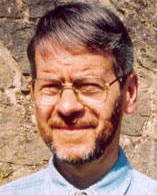Basava Premanand
In his attack on Professor Tulasi Srinivas (entry no. 2 on this site), Gerald Joe Moreno correctly observed that she cited me as “a biographer of Shirdi Sai Baba” (Srinivas, Winged Faith, p. 354 note 24). Moreno was averse to this favourable reference; he insisted upon describing me as “a vanity self-publisher who admitted he is not an academic.” His phraseology is deceptive. I did not need to make any admission, never having posed as an academic. Moreno himself was not an academic; furthermore, he had no books to his credit.
In the same attack feature, Moreno identified me as “a malicious critic of Sathya Sai Baba who has ridiculously accused the Guru of being ‘closely allied with terrorists’ and who fanatically accused Moreno [third person] of being an ‘internet hit man’ and an ‘internet terrorist’.”
These remarks typically lacked context. Moreno had often been accused of fanaticism by victims. My reference to guru-related terrorism followed the reporting of Basava Premanand (1930-2009), the Indian rationalist and major critic of Sathya Sai Baba. Premanand opposed Sathya Sai for many years, contesting the supposedly miraculous feats of that famous guru, which he disproved. Premanand also referred to numerous murders and other problems which he associated closely with Sathya Sai. Many of the details here are unconfirmed. It is nevertheless legitimate (and even obligatory) to cite the output of the major Indian critic. One is not necessarily being at all malicious in so doing. Amongst other matters, Premanand informed the BBC (quite credibly) that he had been attacked by violent pro-guru extremists.
Premanand composed the significant book Murders in Sai Baba’s Bedroom (2001), a tome reporting notorious events in 1993 at Puttaparthi ashram, where six people died violently in a nocturnal episode intimately related to the guru. Moreno declared this lengthy book to be irrational speculation, a mere conspiracy theory. In contrast, Premanand described his book as “a critical analysis of the records which I could collect, including newspaper clippings.”
Premanand replied to the Moreno dismissal at length, revealing the superficial nature of sectarian argument. The Indian rationalist commented: “I am well accustomed to the ploys of Sathya Sai Baba, his organisation, and other supporters whose agenda is to discredit those who seriously question their conduct and beliefs.” The rationalist also stated:
Now that criticisms are being aired to millions in many countries by the BBC and Danish television documentaries (The Secret Swami and Seduced), the Sai Baba forces are desperate to denigrate and vilify those who speak out against them. (Premanand, Reply to Mr. Gerald Moreno, exbaba.com, Search tab)
In a committed project, Premanand demonstrated how many Indian holy men resorted to “miracle” tricks, including sleight of hand. A speciality of Sathya Sai Baba was to produce sacred ash (vibhuti) in his palm, a supposedly miraculous achievement. Even schoolboys can easily perform this deception.
left: holy man with Shiva trident piercing his tongue; right: Premanand showing how the trick is accomplished.
Premanand was a phenomenon, for many years steadfastly opposing Sathya Sai and other gurus. He eventually appeared with fellow rationalist Sanal Edamaruku in the Channel 4 documentary Guru Busters (1995). Along with others in different areas of India, they showed how popular miracle displays of gurus and holy men were sheer deceit. Premanand could enact any so-called “miracle,” teaching other rationalists how to copy these tricks.
He has spent the last forty years investigating miracles and, after witnessing 1,146 of them, he has yet to see one he can’t duplicate through natural methods…. He leads an army of sceptics in ongoing investigations of India’s many god-men. He has been jailed and beaten, his life has been threatened, and his car sabotaged. India’s god-men [primarily Sathya Sai Baba] wield great political power, and number high government officials (including Supreme Court justices) among their followers. (Oscar Gunther and Brian Siano, Premanand: Guru Buster, 1994, exbaba.com)
Premanand also revealed that poor devotees of Sathya Sai received “miracle” holy ash, while the wealthy supporters acquired Rolex wristwatches, diamond necklaces, and Parker pens made in America. All these items were palmed via sleight of hand, in the deceptive manner called “miracles” by Sathya Sai Baba. The miracle beliefs thrived on crass superstition. Even some scientists were deceived by “miracles,” adopting a devotee view of the infallible guru.
Puttaparthi ashram was inseparable from a business complex, including property ownership. The guru’s younger brother Janakiramiah was a multi-millionaire property speculator with a repute for insatiable acquisition. This relative was accused of blackmailing police to shoot four intruders during the bedroom murders in June 1993. As a reward for his supporting role, Sathya Sai made Janakiramiah a prominent member of the tax-exempt Sathya Sai Central Trust, an organisation described by critics as a multi-billion dollar enterprise enabling donations from wealthy devotees to disappear into the pockets of corrupt officials.
Sathya Sai and his Trust received huge donations for charity, while spending too much on “wasteful flagship projects,” to use one description of ex-devotee Robert Priddy. Costly new buildings annually appeared at the ashram, while the guru claimed that he had no property or worldly goods. He charted private passenger jets for VIPs at the Sathya Sai Airport, commenced in 1990 at Puttaparthi (he was not an ecological trendsetter). Sathya Sai enjoyed being driven in expensive motor cars maintained for him at the ashram, including a Jaguar and a Mercedes (he would often journey to Bangalore, site of a second ashram at nearby Whitefield).
The ex-devotee David Bailey, in an online document The Findings, revealed many of the discrepancies at Puttaparthi. For instance, he reported that the ceiling of a prominent mandir (temple) was covered in gold leaf. Bailey queried the contrast with a landscape of dire rural poverty. He also informed that this temple had acquired 167 chandeliers instead of the original 36.
Devotees frequently made much of the charitable projects associated with Puttaparthi; the anomalies were ignored. Bailey investigated the Sai Baba Water Project, which claimed to benefit 750 villages with money obtained from elaborate fund-raising. He discovered that the grand claim was false. Only a relatively small number of villages, plus Puttaparthi ashram, gained a water pipeline. A Telegu newspaper, of the 1990s, accordingly stated: “Sai Baba, where is our water? You have cheated us again!”
Any mention of deficiencies was interpreted by Gerald Joe Moreno in terms of conspiracy and groundless allegation. After the deaths of both Moreno and Sathya Sai, the private hoard of the guru was revealed in two different locations, including substantial wealth and over seven hundred “renunciate” robes of the type he liked to wear. The guru’s following then became notorious for squabbling over the economic endowments of Puttaparthi ashram. Rationalist critic Sanal Edamaruku complained that the private hoard was not accounted for, amounting to “black money.” The Sathya Sai Central Trust nevertheless claimed to own the hoard, while relatives of the guru protested at events controlled by the Trust.
The Murders book of Premanand includes many details. The Sathya Sai Airport cost one and a half billion rupees, being constructed at Puttaparthi by the Indian Airport Authority (IAA). Rarely used, the facility is described as being of a private character. Another source informs that Sathya Sai persuaded the IAA to finance the project, saying they would earn 10 lakhs of rupees the first year. This prediction transpired to be totally wrong. The Airport was largely unused for years before the first commercial flight. The occasional VIP arrived at the ashram by private jet. The Sathya Sai Central Trust “apparently ended up owning” the new airport (White Elephant for Sale).
In 1998, at a hotel near the Sathya Sai Airport, a tragic collective suicide occurred. This was reported by Premanand. The event is viewed as confirmation of the danger in extremist devotee attitudes. Ramesh (aged 42) was a multi-millionaire industrialist and a devotee of Sathya Sai. He was found dead with seven other family members lying unconscious on the floor, plus his daughter who had died of a brain tumour a day earlier. Only one of these people survived. Police concluded that they died of shock at the daughter’s death, having expected Sathya Sai to miraculously save her. Ramesh left a note saying: “I myself have influenced all the members [of my family] to commit suicide to become one with Sai Baba…. All our properties have to be transferred to the Sathya Sai [Central] Trust.”
The same extensive Murders book refers to a legal petition, dated 1994, via the lawyer K. N. Balgopal (advocate for Premanand). This document reported that an Australian lady was murdered in her room at the Puttaparthi ashram in 1993. “The entire incident was hushed up.” The victim was a member of the Sathya Sai Central Trust, being connected with an ousted secretary of that divided body. Trust members were here accused of misusing funds and indulging in illegal activities. Some Trust members were also accused of using local thugs to murder foreign devotees and burn the faces of corpses beyond recognition. “A foreigner was raped at the ashram by a Trust member, but the police hushed up the case” (Excerpts from B. Premanand’s book, online at exbaba.com).
Another source reported that, in 1992, a woman was killed and dismembered in her room at Puttaparthi village (Testimony from David Paul, exbaba.com). David Paul became a devotee in the early 1980s, and visited Puttaparthi in 1992. A related episode, more well known, is that of a man whose stomach was cut out while he was still alive. These grim events at Puttaparthi are inseparably associated with the goondas (thugs) goaded on by the Sathya Sai Central Trust.
Premanand reported that his son was murdered by Sathya Sai goondas in a hospital at Bangalore. These thugs also threatened his brother. The home of Premanand was repeatedly burgled by these agents of violent intrigue. They stole compromising documents on Sathya Sai, also related memoranda in the form of photographs and DVDs. A major obstruction to justice was Bhagwati, the Supreme Court Judge, who was conveniently a member of the Sathya Sai Central Trust. All complaints and legal procedures were blocked by the Puttaparthi mafia.
I did indeed accuse Gerald Joe Moreno (alias Equalizer, SSS108) of being an internet terrorist, a phrase which appeared in the title of a web article composed in 2009. That description arose because of his continued hostility, despite my complaints commencing in 2007, complaints which had appeared on two websites of mine. One of those complaints related to the fact that Moreno had duplicated hostile and misleading accounts of myself (found on his website saisathyasai) on a blogspot cycle featuring the pseudonym of Equalizer (i.e., Moreno).
This belligerent excess in my direction was matched by similar gestures against ex-devotees. His manic campaign was determined to offset all criticism of Sathya Sai and Puttaparthi ashram. Many observers were prepared to credit my description of “internet terrorist.” Moreno had gained the reputation of a cyberstalker.
The Moreno output is classifiable in the basic sense implied by the phrase “hate campaign,” meaning attack blogs that exhibit vehement and distorted arguments frequently tending to libel. See Hate Campaign Blogs. Obsessive multi-entry blogs targeting the same victim are an indication of strong antipathy. Gerald Joe Moreno (Equalizer) achieved nine of these inquisitions at blogspot, in addition to his deadly website saisathyasai.com, described by some victims as the portal to hell. Such treatment can easily arouse retaliation, which may be necessary for self-defence.
Equalizer (Moreno) resorted to an animation device on his blogspot attacks. This device declared a “Campaign to stop Anti-Sai Activist’s Abuse.” The word Abuse here alternated with Defamation, Libels, and Dishonesty. This verbalism reflected the attitude of Moreno that all testimonies of sexual abuse made against Sathya Sai Baba were hopelessly wrong, and therefore all condoning reference to those testimonies was a crime. In Moreno language, any emphasis on critical reporting meant Dishonesty and Abuse.
In this perspective, the victims testifying to sexual abuse were despicable Anti-Sai Abusers. That was the basic gist of Moreno’s aggressive argument about the “Anti-Sai” contingent. This conceptual scheme was viewed by Moreno (Equalizer) as granting him the right to denigrate all critics, who were treated to vehemently contemptuous dismissals.
From 2004, Moreno became the major (though unofficial) web apologist for the Sathya Sai Organisation. His attack site demonstrated fervent “Pro-Sai” enthusiasm, denouncing critics of Sathya Sai Baba. Gerald Joe Moreno also maintained an extensive blog entitled sathyasaibaba at wordpress, which again exhibited the pseudonym of Equalizer, who deceptively claimed to mediate “love and spirituality.”
Critics objected that the “love and spirituality” decoded to an intensive mode of hate campaign discernible across the spectrum of Moreno web activity. At blogspot.com, Moreno (Equalizer) specifically described his presentation in terms of a campaign against critics of Sathya Sai Baba.
His strategy on Google Search aroused increasing resistance. Moreno continually accused his critics of “deception.” His entries on Google Search name listings (of his victims) became notorious for disparaging statements and aspersions which showed conspicuously on those listings. See further Moreno and Ex-Devotees.
Kevin R. D. Shepherd
October 2013 (modified 2021)
ENTRY no. 3
Copyright © 2021 Kevin R. D. Shepherd. All Rights Reserved.
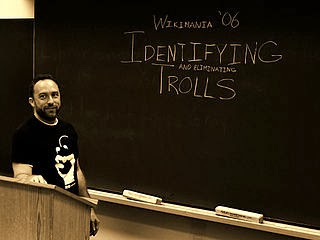 Wikipedia manager Jimmy Wales in 2006 at a Wikimania conference discussing the identification and elimination of trolls.
Wikipedia manager Jimmy Wales in 2006 at a Wikimania conference discussing the identification and elimination of trolls.

 Dr. Michael Goldstein in The Secret Swami documentary
Dr. Michael Goldstein in The Secret Swami documentary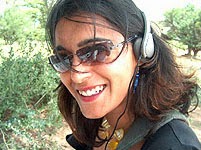 BBC reporter Tanya Datta
BBC reporter Tanya Datta Simon Kidd
Simon Kidd Cambridge University Library
Cambridge University Library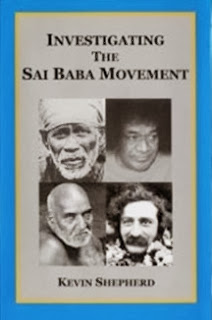
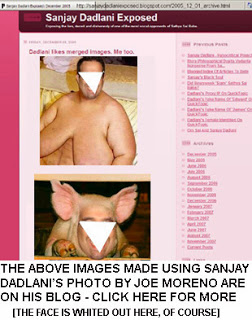
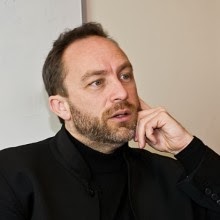 Jimmy Wales (Jimbo)
Jimmy Wales (Jimbo)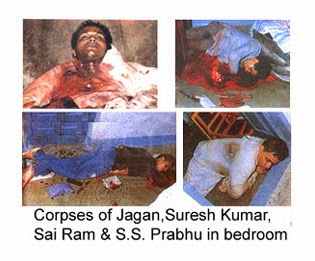
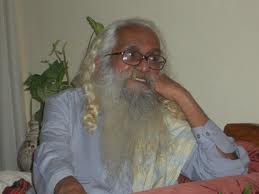
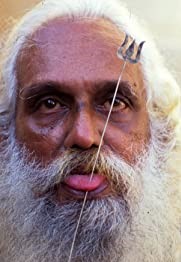
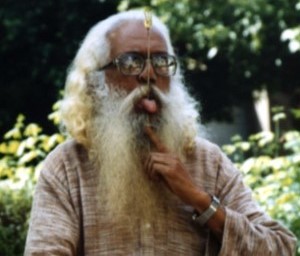
 Professor Tulasi Srinivas
Professor Tulasi Srinivas